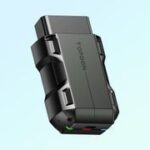The ELM327 OBD2 Bluetooth adapter is a popular tool for diagnosing car problems. This user manual provides a comprehensive guide to understanding its features, functionality, and how to use it effectively. Learn how to connect, troubleshoot, and maximize the potential of your ELM327 device.
Understanding the ELM327 OBD2 Bluetooth Adapter
The ELM327 is a small, inexpensive device that plugs into your car’s OBD-II port, usually located under the dashboard. It communicates with your smartphone, tablet, or laptop via Bluetooth, allowing you to access your vehicle’s diagnostic data. This data can help you identify potential issues, understand warning lights, and monitor your car’s performance. This device supports all OBD-II protocols:
- ISO15765-4 (CAN)
- ISO14230-4 (KWP2000)
- ISO9141-2
- J1850 VPW
- J1850 PWM
Connecting Your ELM327 Device
- Locate your OBD-II port: It’s typically under the dashboard on the driver’s side.
- Plug in the ELM327 adapter.
- Turn on your car’s ignition: This powers the adapter.
- Pair your device: Enable Bluetooth on your smartphone, tablet, or laptop and search for the ELM327 device. The name often appears as “OBDII” or similar. Enter the pairing code if required (often “0000” or “1234”).
- Launch a compatible app: Numerous OBD-II apps are available for Android, iOS, and Windows. Torque Pro, OBD Car Doctor, and CarLog are popular choices.
Troubleshooting Common Issues
“This soft wear not installed on this version” Error: This message, often seen when pressing the “TEST” button on some ELM327 devices, indicates an incorrect COM port setting.
Changing the COM Port Number (For Windows Users):
- Open Device Manager: Search for it in the Windows search bar.
- Select “View devices by type”, then “Ports (COM & LPT)”.
- Right-click on the USB serial port associated with your ELM327 and select Properties.
- Navigate to the Port Settings tab and click Advanced.
- Change the COM port number to an available one and click OK. Consult your OBD-II software documentation for specific instructions on setting the correct COM port.
Frequently Asked Questions (FAQs)
Q: What’s the difference between V1.5, plastic, and Bluetooth ELM327 adapters?
A: They have the same functionality. The difference lies in the interface: V1.5 has both USB and COM interfaces, the plastic version typically has only USB, and the Bluetooth version connects wirelessly.
Q: What does the “Freeze Frame” data mean?
A: Freeze Frame data captures a snapshot of various sensor readings at the moment a fault code was triggered. This information helps diagnose the specific conditions that caused the problem. Consult your OBD-II software or app documentation for details on accessing and interpreting Freeze Frame data.
Choosing the Right OBD-II Software
Selecting the right software is crucial for utilizing the ELM327’s full potential. Consider factors like operating system compatibility (Android, iOS, Windows), features offered (code reading/clearing, live data, graphing), and user reviews.
Popular Software Options:
- Torque Pro (Android): A highly rated app with extensive features and customization options.
- OBD Car Doctor (Android/iOS): A user-friendly app for basic diagnostics and monitoring.
- FORScan (Windows): Powerful software specifically designed for Ford, Mazda, Lincoln, and Mercury vehicles.
Using Your ELM327: Reading and Clearing Codes
Once connected and paired with a suitable app, you can:
- Read Diagnostic Trouble Codes (DTCs): These codes indicate specific problems within your vehicle’s systems.
- Clear DTCs: After resolving an issue, you can clear the corresponding codes.
- View Live Data: Monitor real-time sensor readings such as engine speed, coolant temperature, and fuel pressure. This helps understand your vehicle’s performance and identify potential issues.
Conclusion
The ELM327 OBD2 Bluetooth adapter is a valuable tool for car owners of all levels. By understanding its functionality and using it correctly, you can gain insights into your vehicle’s health, diagnose problems, and potentially save money on repairs. Remember to consult your specific device and software documentation for detailed instructions and troubleshooting tips.

